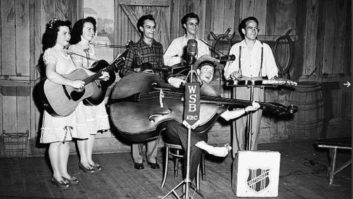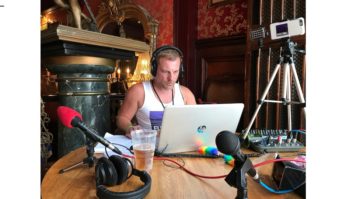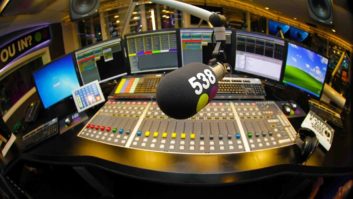Anyone from the radio business who’s been to a dance club lately may have noticed that the equipment used by the DJs looks pretty unfamiliar. Back in the day (i.e., through the 1990s) radio and club DJs’ work was relatively interchangeable (other than the choice of music, perhaps), but this is no longer the case. Over the past several years, the art and tech of the club DJ has made significant departures from radio DJ work.
Of course, most radio DJs now work almost completely by computer, in many cases preparing shows offline, and allowing an automation system to assemble the program at play-out time. But this isn’t where the real difference lies. Club DJ work remains more manual, visceral and real-time, but digital technology has also been implemented there. It is just how digital systems have been developed and implemented in the club DJ space that creates some fascinating divergences.
The compact DJ
There are two main classes of new technology that have been developed for the club DJ world, and many of the top clubs and DJs use one or both today.
The first is generically referred to as the “CDJ,” for a class of CD players designed specifically for club DJs by Pioneer, which markets the line with various model numbers after the common CDJ-prefix. (Pioneer refers to this product line as Digital Vinyl Turntables.) The products have been available since the early 2000s, and quickly became popular, with numerous upgrades since. Like the Mini-Moog in the 1970s, or the pianoforte in the late 18th century, the device’s design has changed the way music is created (or perhaps in this case, “re-created”).
The primary differences between the CDJ device and a regular professional CD player is the addition of a “scratch table,” by which DJs can adjust the motion of the CD by grabbing and spinning a rotating platter on the top surface of the player, much like they would to a vinyl turntable. The CD itself does not actually move in response to these platter movements, but audio in a large on-board RAM buffer is played out of the device as if it were. Thus the platter is a “virtual” turntable.
The CDJs also include several on-board samplers, into which the DJ can input short selections of audio from a CD (by hitting start and stop buttons on the fly as “in” and “out” points go by). These samples can then be played out (forward or reverse) on command, either as a single play or a continuous loop. The samplers can play independently or together through an on-board mixer, and can be mixed with real-time audio coming from the CD. The latest units also support MP3 file playback from CDs.
Le Club Computer
The other new digital technology used in the club DJ space is, like most of radio today, computer-based audio, but with a twist — literally. Music cuts are stored on a PC (typically a laptop) hard drive, and viewed or selected via a directory, as with radio automation systems, but in this case the PC audio application accepts transport control input for the audio files from peripheral devices. Those devices are a pair of CD players or analog turntables (or one of each), connected to the PC through an outboard USB hardware interface box.
The system comes with several CDs and vinyl LPs, which are pressed throughout with a continuous sync signal. Any variation in pitch from the sync signal’s nominal frequency is interpreted by the PC as a control signal, in which case the audio playing from the hard drive at that moment (again, loaded into a large RAM buffer) is played out — backwards or forwards, fast or slow, in accordance with the movement of the LP or CD with the control track. Two separate audio files can be played (or cued) simultaneously, with one control disc assigned to each. On the latest incarnations of these systems, the correspondence of the discs’ movements to the PC audio files is so precise that experienced DJs say they typically forget that the audio they’re hearing isn’t actually pressed on the discs they’re manipulating.
When using these systems, the DJs never need change the LPs or CDs (unless they wear out or get damaged), and they can drop the stylus (or laser pickup) anywhere on the discs and hit play to establish manual transport control of the assigned PC audio file. The selected music plays from the PC hard drive as it exists in the original file until the control signal from the CD player or turntable tells it to do otherwise.
Another obvious advantage of this system is its compactness and convenience of access to a large library of music. These systems typically accommodate a variety of compressed or uncompressed audio file formats, so all the music a DJ might need can be preloaded into a laptop, with every cut available via a quick scan of the directory, or a search by artist, title, album, genre or whatever — yet still controllable as if the tunes were spinning on palpable, removable media.
The system that seems to be most in favor among the DJ culture today comes from a New Zealand company called Serato, which markets its popular Serato Scratch Live system via exclusive license to Seattle-based Rane Corp. (Rane produces the USB hardware interface device mentioned above for Serato Scratch Live.) The system runs on PC or Mac, and supports a range of audio coding formats. Other similar systems are Stanton’s Finalscratch, Alcatech’s Digiscratch and PCDJ’s Scratch.
Geeks need love, too
For old school radio jocks, watching a skilled contemporary club DJ use either of these systems is really fun. The choreography involved with the CDJ operation is a kind of digital ballet, and watching the PC screen display respond to the movements of an old Technics turntable is very cool.
One current system shows an animated graphic that is simulates a virtual view of the record groove flying past the stylus, with the audio file’s waveform cut into to the groove walls, and moving backwards and forwards past the style cursor as the control disc spins. All of the systems show some kind of visual waveform display, but because the entire audio file is on the PC (and is partially preloaded into a RAM buffer), the display shows audio data in both temporal directions around the stylus. The displays typically show a graphical representation of the turntables’ or CD players’ rotation, as well, creating a neat visual hybrid of the digital audio data file and its mechanical control via the peripheral device.
So next time a colleague drags you along to the hippest dance club in town, at least you’ll know that while he or she is out on the dance floor or schmoozing the hotties, you’ll have something interesting to check out, too.










